
6PDUW/RFN
70
+RPH(TXLW\/LQHRI&UHGLW'LVFORVXUH3DFNHW
7KDQN\RXIRUFKRRVLQJ2UUVWRZQ%DQNIRU\RXUILQDQFLQJQHHGV
7KLVSDFNHWFRQWDLQVLPSRUWDQWLQIRUPDWLRQDERXW2UUVWRZQ%DQN¶V6PDUW/RFN
70
+RPH(TXLW\
/LQHRI&UHGLWSURGXFW 3OHDVHUHYLHZFDUHIXOO\DQGUHWDLQDFRS\IRU\RXUUHIHUHQFH ,IIRU
DQ\UHDVRQ\RXFDQQRWSULQWWKHGLVFORVXUHVSOHDVH FRQWDFWXVDW
7KLVSDFNHWFRQWDLQVWKHIROORZLQJGLVFORVXUHVIRU\RXUUHYLHZ
x ,PSRUWDQW7HUPV$ERXW2XU+RPH(TXLW\$SSOLFDWLRQ'LVFORVXUH
x 3ULYDF\1RWLFH
x :KDW<RX6KRXOG.QRZ$ERXW+RPH(TXLW\/LQHVRI&UHGLW
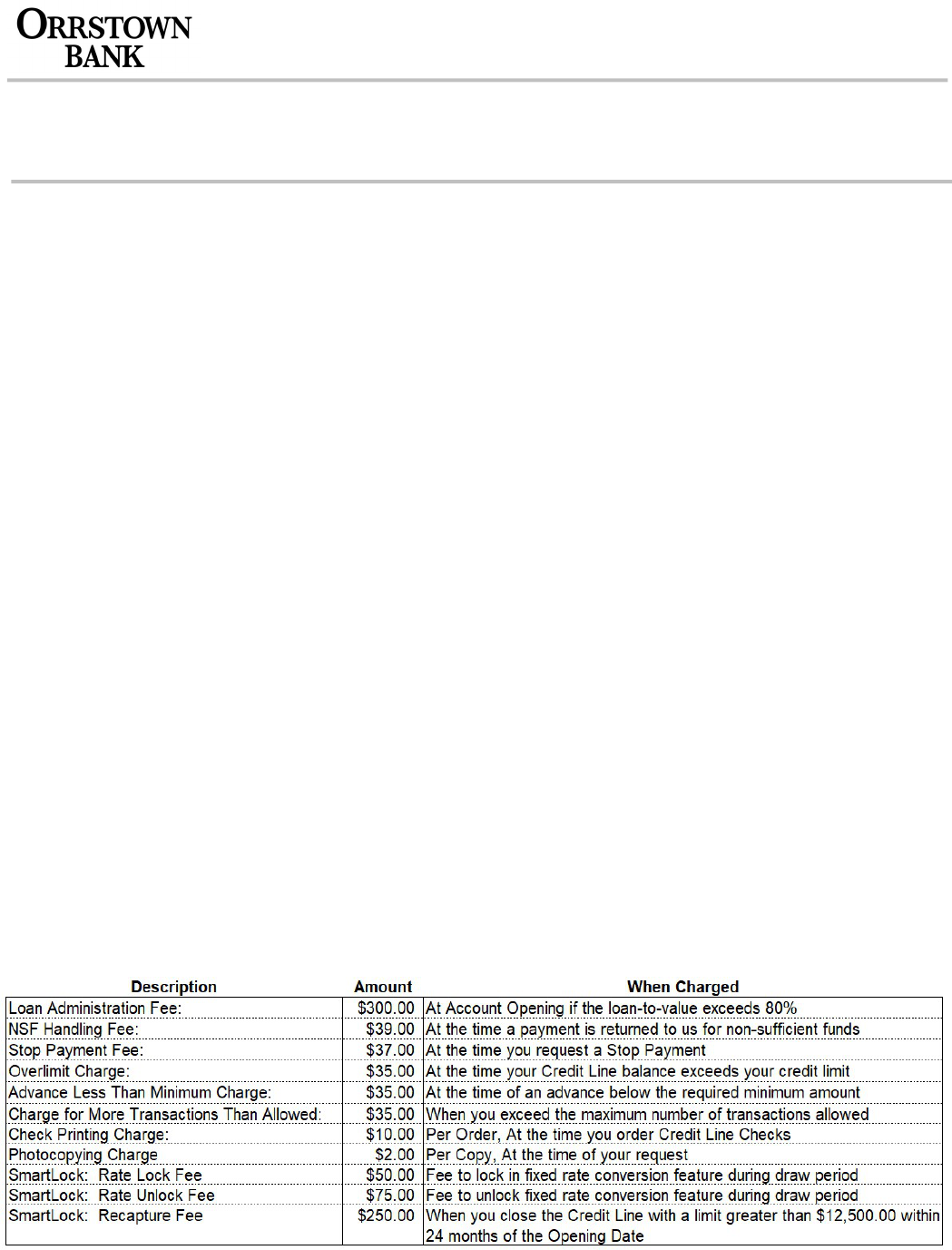
Lender: Orrstown Bank
P O Box 250
Shippensburg, PA 17257
Home Equity Application Disclosure
IMPORTANT TERMS OF OUR HOME EQUITY APPLICATION DISCLOSURE
This disclosure contains important information about our PA/WV SmartLock Interest Only Home Equity Line of Credit (the "Plan").
You should read it carefully and
keep a copy for your records.
AVAILABILITY OF TERMS. All of the terms of the Plan described herein are subject to change. If any of these terms change (other than the
ANNUAL PERCENTAGE RATE) and you decide, as a result, not to enter into an agreement with us, you are entitled to a re
fund of any fees
that
you paid to us or anyone else in connection with your application.
SECURITY INTEREST. We will take a security interest in your home. You could lose your home if you do not meet the obligations in your
agreement with us.
POSSIBLE ACTIONS. Under this Plan, we have the following rights:
Termination and Acceleration. We can terminate the Plan and require you to pay us the entire outstanding balance in one payment,
and charge you certain fees, if any of the following happens:
(a)
You commit fraud or make a material misrepresentation at any time in connection with the Plan. This can include, for example,
a false statement about your income, assets, liabilities, or any other aspect of your financial condition.
(b)
You do not meet the repayment terms of the Plan.
(c)
Your action or inaction adversely affects the collateral for the Plan or our rights in the collateral. This can include, for example,
failure to maintain required insurance, waste or destructive use of the dwelling, failure to pay taxes
, death of all persons liable on
the account, transfer of title or sale of the dwelling, creation of a senior lien on the dwelling without our permission, foreclosure
by the holder of another lien or the use of funds or the dwelling for prohibited purposes.
Suspension or Reduction. In addition to any other rights we may have, we can suspend additional extensions of credit or reduce your
credit limit during any period in which any of the following are in effect:
(a)
The value of your dwelling declines significantly below the dwelling's appraised value for purposes of the Plan. This includes,
for example, a decline such that the initial difference between the credit limit and the available equity is reduced by fifty percent
and may include a smaller decline depending on the individual circumstances.
(b)
We reasonably believe that you will be unable to fulfill your payment obligations under the Plan due to a material change in your
financial circumstances.
(c)
You are in default under any material obligation of the Plan. We consider all of your obligations to be material. Categories of
material obligations include, but are not limited to, the events described above under Termination and Acceleration , obligations
to pay fees and charges, obligations and limitations on the receipt of credit advances, obligations concerning maintenance or
use of the dwelling or proceeds, obligations to pay and perform the terms of any other deed of trust, mortgage or lease of the
dwelling, obligations to notify us and to provide documents or information to us (such as updated financial information),
obligations to comply with applicable laws (such as zoning restrictions).
(d)
We are precluded by government action from imposing the annual percentage rate provided for under the Plan.
(e)
The priority of our security interest is adversely affected by government action to the extent that the value of the security int
erest
is less than 120 percent of the credit limit.
(f)
We have been notified by governmental authority that continued advances may constitute an unsafe and unsound business
practice.
(g)
The maximum annual percentage rate under the Plan is reached.
Change in Terms. We may make changes to the terms of the Plan if you agree to the change in writing at that time , if the change will
unequivocally benefit you throughout the remainder of the Plan, or if the change is insignificant (such as changes relating to our data
processing systems).
Fees and Charges. In order to open and maintain an account, you must pay certain fees and charges.
Lender Fees. The following fees must be paid to us:
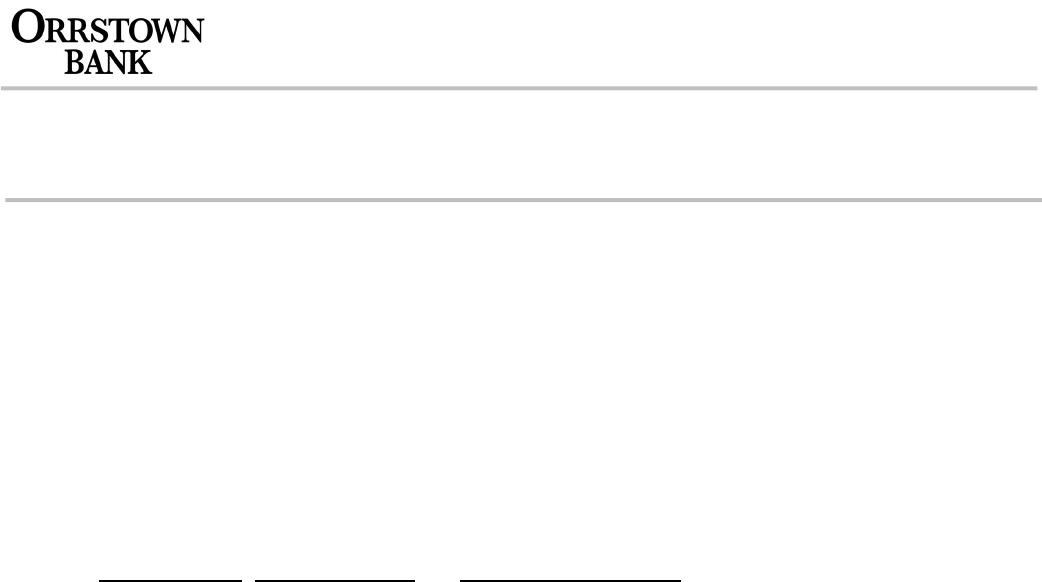
Lender: Orrstown Bank
P O Box 250
Shippensburg, PA 17257
Home Equity Application Disclosure
Late Charge. Your payment will be late if it is not received by us within 16 days after the "Payment Due Date" shown on your
periodic statement. If your payment is late we may charge you 10.000% of the payment or $20.00, whichever is greater.
Third Party Fees. If you are purchasing a property that will also secure the Credit Line, you must pay certain fees to third parties
such as appraisers, credit reporting firms, and government agencies. These third party fees generally total between $300.00 and
$4,580.00 (for a Credit Line amount of $100,000.00). Upon request, we will provide you with an itemization of the fees y
ou have to pay
to third parties.
PROPERTY INSURANCE. You must carry insurance on the property that secures the Plan.
MINIMUM PAYMENT REQUIREMENTS. You can obtain advances of credit during the following period: for a period of ten years from the
Opening Date. You may however begin the amortization period sooner than ten years, which would discontinue your draw period at that time
(the "Draw Period"). After the Draw Period ends, the repayment period will begin. You will no longer be able to obtain credit advances. The
length of the repayment period is as follows: for a period of twenty years. Your Regular Payment will equal the amount of your accrued
FINANCE CHARGES ("First Payment Stream"). You will make 120 of these payments. Your payments will be due monthly. Your "Minimum
Payment" will be the Regular Payment, plus any amount past due and all other charges. An increase in the ANNUAL PERCENTAGE RATE
may increase the amount of your Regular Payment. The Minimum Payment during the First Payment Stream will not reduce the principal that is
outstanding on your Credit Line.
After completion of the First Payment Stream, your Regular Payment will be based on an amortization of your balance at the st
art of this payment
period as shown below (“Second Payment Stream”). Your payments will be due monthly.
Range of Balances Number of Payments Regular Payment Calculation
All Balances 240 240 payments
Your "Minimum Payment" will be the Regular Payment, plus any amount past due and all other charges.
A change in the ANNUAL PERCENTAGE RATE can cause the balance to be repaid more quickly or more slowly. When rates decrease, less
interest is due, so more of the payment repays the principal balance. When rates increase, more interest is due, so less of the payment repays
the principal balance. If this happens, we may adjust your payment as follows: your payment may be increased by the amount necessary to
repay the balance by the end of this payment stream. Each time the ANNUAL PERCENTAGE RATE changes, we will review the effect the
change has on your Credit Line Account to see if your payment is sufficient to pay the ba
lance by the Maturity Date. If it is not, your payment will
be increased by an amount necessary to repay the balance by the Maturity Date.
MINIMUM PAYMENT EXAMPLE.
Loan-to-Value 80% or Less: If you made only the minimum payment and took no other credit advances, it would take 30 years to pay off
a credit advance of $10,000.00 at an ANNUAL PERCENTAGE RATE of 8.25%. During that period, you would make 120 monthly
payments ranging from $63.29 to $70.07. Then you would make 240 monthly payments ranging from $82.65 to $85.23. We have used
this rate of 8.25% recently on Credit Lines less than $100,000.00.
Loan-to-Value Exceeds 80%: If you made only the minimum payment and took no other credit advances, it would take 30 years to pay
off a credit advance of $10,000.00 at an ANNUAL PERCENTAGE RATE of 9.50%. During that period, you would make 120 monthly
payments ranging from $72.88 to $80.68. Then you would make 240 monthly payments ranging from $89.63 to $93.24.
TRANSACTION REQUIREMENTS. The following transaction limitations will apply to the use of your Credit Line:
Credit Line Credit Line Check Limitations. The following transaction limitations will apply to your Credit Line and the writing of Credit
Line Checks.
Maximum Number of Advances Per Period. The maximum number of advances that you may obtain per month is 10.
Minimum Advance Amount. The minimum amount of any credit advance that can be made on your Credit Line is $100.00. This
means any Credit Line Check must be written for at least the minimum advance amount.
Telephone Request Limitations. The following transaction limitations will apply to your Credit Line and requesting an advance by
telephone.
Maximum Number of Advances Per Period. The maximum number of advances that you may obtain per month is 10.
Minimum Advance Amount. The minimum amount of any credit advance that can be made on your Credit Line is $100.00.
Overdraft Limitations. The following transaction limitations will apply to your Credit Line and writing a check in excess of your checking
account balance.
Maximum Number of Advances Per Period. The maximum number of advances that you may obtain per month is 20.
Minimum Advance Amount. The minimum amount of any credit advance that can be made on your Credit Line is $50.00.
Other Transaction Requirements. If the credit line balance is less than $50.00, and the overdraft is less than $50.00, the amount of
the overdraft will be taken.
In Person Request Limitations. The following transaction limitations will apply to your Credit Line and requesting an advance in person.
Maximum Number of Advances Per Period. The maximum number of advances that you may obtain per month is 10.
Minimum Advance Amount. The minimum amount of any credit advance that can be made on your Credit Line is $100.00.
Internet Banking Limitations. The following transaction limitations will apply to your Credit Line and accessing by other methods.
Maximum Number of Advances Per Period. The maximum number of advances that you may obtain per month is 10.
Minimum Advance Amount.
The minimum amount of any credit advance that can be made on your Credit Line is $100.00.

Lender: Orrstown Bank
P O Box 250
Shippensburg, PA 17257
Home Equity Application Disclosure
CONVERSION OPTION.
This agreement contains an option to convert a portion or all of the balance under your Credit Line from a variable
ANNUAL PERCENTAGE RATE to a fixed ANNUAL PERCENTAGE RATE as determined below. Each portion of the balance under your
Credit
Line you convert to a fixed ANNUAL PERCENTAGE RATE is referred to as a “Fixed-Rate Advance.” The following information describes the
terms and features of the conversion option available under this Agreement:
ANNUAL PERCENTAGE RATE Increase. Your ANNUAL PERCENTAGE RATE may increase if you exercise this option to convert
to a fixed rate.
Conversion Periods. You can exercise the option to convert to a fixed rate only during the following period or periods: You can
exercise the option to convert to a fixed ANNUAL PERCENTAGE RATE at any time during the Draw Period, and any extension of the Draw
Period. After the Draw Period ends, or if you do not meet the repayment terms of this credit agreement, you will not be able to exercise the
option to convert to a fixed ANNUAL PERCENTAGE RATE.
Conversion Fees. You will be required to pay the following fees at the time of the conversion to a fixed rate: a rate lock fee of
$50.00 each time you exercise the option to convert to a fixed ANNUAL PERCENTAGE RATE. This is a FINANCE CHARGE. You will be
required to pay a rate unlock fee of $75.00 each time you exercise the option to convert to a variable ANNUAL PERCENTAGE RATE. This is a
FINANCE CHARGE.
Rate Determination: The fixed rate will be determined as follows: The fixed rate will be based on certain credit criteria and length of
the fixed rate term, in conjunction with our published rates for a closed-end home equity loan at the time of the conversion request.
Conversion Rules. You can convert to
a fixed rate only during the period or periods described above. In addition, the following rules
apply to the conversion option under this agreement: You can exercise the option to convert to a fixed ANNUAL PERCENTAGE RATE only
during the period or periods described above. The minimum fixed rate advance is $5,000.00.
(a)
Minimum and maximum term. If you exercise the option to convert to a fixed ANNUAL PERCENTAGE RATE, the term of the Fixed-
Rate Advance cannot be less than twelve (12) months or longer than two hundred and forty (240) months.
(b)
Number of Fixed-
Rate Advances. You can exercise the option to convert to a fixed ANNUAL PERCENTAGE RATE from time to time,
but you may not have more than five (5) different Fixed Rate Advances outstanding under your Credit Line Account at any one time.
(c)
Ineligible for Promotional Rates. In determining your interest rate and ANNUAL PERCENTAGE RATE as described in the Rate
Determination paragraph above, our published closed-end home equity loan interest rates and ANNUAL PERCENTAGE RATE will
not include any special, promotion or coupon interest rates and interest rates available only for newly opened accounts. If we offer a
discounted interest rate and ANNUAL PERCENTAGE RATE for agreeing to make payments through automatic deduction from a
checking account maintained with us, that discounted rate will be considered the published rate for purposes of the Rate
Determination paragraph above, only if you have agreed to have payments under your Credit Line Account automatically deducted
from a checking account you maintain with us.
(d)
Complete Election Form. In order to exercise the option to convert to a fixed ANNUAL PERCENTAGE RATE, you must complete the
SmartLock Rate Lock Request Form.
(e)
Minimum Monthly Payments. At the time you exercise the option to convert to a fixed ANNUAL PERCENTAGE RATE, we will
determine a minimum monthly payment applicable to that Fixed-Rate Advance. The minimum monthly payment will include both
principal and interest and will be sufficient to repay the Fi
xed Rate Advance in equal monthly installments of principal and interest over
the term of the Fixed Rate Advance. The minimum monthly payment with respect to a Fixed-Rate Advance will not be less than
$50.00. If you have more than one Fixed-Rate Advance outstanding, you will have to make minimum monthly payments with respect
to each Fixed Rate Advance. The minimum monthly payments due with respect to Fixed Rate Advances will be in addition to the
Minimum Payment due with respect to any balance under your Credit Line subject to a variable ANNUAL PERCENTAGE RATE.
(f)
How Payments Are Applied If You Have A Fixed-Rate Advance Outstanding. Separate billing will be provided for each Fixed-Rate
Advance. Payments include principal and interest. Unless otherwise agreed or required by applicable law, payments will be applied
first to any accrued unpaid interest; then to principal; then to any late charges; and then to any unpaid collection costs. In the event
you make a payment in excess of the amount necessary to pay all of these amounts, the excess will be first applied to reduce any
principal outstanding. Any prepayments of principal will not reduce the amount of, or extend the due date for, any future minimum
monthly payments.
(g)
Unlock Requirement. The fixed rate portion must be in effect for a minimum of 365 days before you can exercise your option to
convert the fixed rate portion into a variable rate. You will need to execute the SmartLock Rate Unlock Request Form to convert back
to a variable rate feature after the 365 day fixed rate period, if desired.

Lender: Orrstown Bank
P O Box 250
Shippensburg, PA 17257
Home Equity Application Disclosure
TAX DEDUCTIBILITY. You should consult a tax advisor regarding the deductibility of interest and charges for the Plan.
ADDITIONAL HOME EQUITY PROGRAMS. Please ask us about our other available Home Equity Line of Credit plans.
VARIABLE RATE FEATURE. The Plan has a variable rate feature. The ANNUAL PERCENTAGE RATE (corresponding to the periodic rate),
and the minimum payment amount can change as a result. The ANNUAL PERCENTAGE RATE does not include costs other than interest.
THE INDEX. The annual percentage rate is based on the value of an index (referred to in this disclosure as the "Index"). The Index is the Wall
Street Prime. Information about the Index is available or published in the Wall Street Journal. We will use the most recent Index value available
to us as of the date of any annual percentage rate adjustment. If the Index is no longer available, we will choose a new Index and margin. The
new Index will have an historical movement substantially similar to the original Index, and the new Index and margin will result in an annual
percentage rate that is substantially similar to the rate in effect at the time the original Index becomes unavailable.
ANNUAL PERCENTAGE RATE. To determine the Periodic Rate that will apply to your First Payment Stream , we add a margin to the value of
the Index, round that sum up to the nearest 0.125%, then divide the rounded value by the number of days in a year (daily). To obtain the
ANNUAL PERCENTAGE RATE we multiply the Periodic Rate by the number of days in a year (daily). This result is the ANNUAL
PERCENTAGE
RATE for your First Payment Stream. To determine the Periodic Rate that will apply to your Second Payment Stream , we add a margin to the
value of the Index, round that sum up to the nearest 0.125%, then divide the rounded value by the number of days in a year
(daily). To obtain the
ANNUAL PERCENTAGE RATE we multiply the Periodic Rate by the number of days in a year (daily). This result is the
ANNUAL PERCENTAGE
RATE for your Second Payment Stream. A change in the Index rate generally will result in a change in the ANNUAL PERCENTAGE RATE. The
amount that your ANNUAL PERCENTAGE RATE may change also may be affected by the lifetime annual percentage rate limits, as discussed
below.
Initial Annual Percentage Rate Discount. The initial annual percentage rate is “discounted” – it is not based on the Index and margin
used for later rate adjustments. The initial discounted rate will be in effect for six (6) months. The interest rate of 4.35% will be
calculated and in effect for 6 months from the original date of the Credit Agreement and Disclosure. Offer valid ONLY on new
SmartLock customers. Additional credit score and loan-to-value restrictions may apply which may impact the initial annual percentage
rate.
Please ask us for the current Index value, margin, discount and annual percentage rate. After you open a credit line, rate information
will be provided on periodic statements that we send to you.
PREFERRED VARIABLE RATE. The ANNUAL PERCENTAGE RATE under the Plan includes a preferred variable rate which is subject to the
following rules and provisions:
Description of Event That Would Cause Lender to Increase the ANNUAL PERCENTAGE RATE. Automatic drafting of payment
from an Orrstown Bank checking or savings account is discontinued.
How The New Rate Will Be Determined. As determined above, the ANNUAL PERCENTAGE RATE under this Plan is variable based
on the Index value plus a margin. Should the event described above occur, the ANNUAL PERCENTAGE RATE will be increased as
follows: by adding 0.75% to the current rate.
FREQUENCY OF ANNUAL PERCENTAGE RATE ADJUSTMENTS. Your ANNUAL PERCENTAGE RATE can change quarterly. There is no
limit on the amount by which the annual percentage rate can change during any one year period. However, under no circumstances will your
ANNUAL PERCENTAGE RATE exceed 18.000% per annum or, except for any initi
al discount period, go below 3.250% per annum at any time
during the term of the Plan.
MAXIMUM RATE AND PAYMENT EXAMPLE.
Draw Period. If you had an outstanding balance of $10,000.00, the minimum payment at the maximum ANNUAL PERCENTAGE RATE of
18.000% would be $152.88. This ANNUAL PERCENTAGE RATE could be reached at the time of the 1st payment.
Repayment Period. If you had an outstanding balance of $10,000.00, the minimum payment at the maximum ANNUAL PERCENTAGE
RATE of 18.000% would be $154.36. This ANNUAL PERCENTAGE RATE could be reached at the time of the 1st payment during the
repayment period.
PREPAYMENT. You may prepay all or any amount owing under the Plan at any time without penalty.
HISTORICAL EXAMPLE. The examples below show how the ANNUAL PERCENTAGE RATE and the minimum payments for a single
$10,000.00 credit advance would have changed based on changes in the Index from 2010 to 2024. The Index values are from the following
reference period: as of 1st week ending in July. While only one payment per year is shown, payments may have varied during each year.
Different outstanding principal balances could result in different payment amounts.
The table assumes that no additional credit advances were taken, that only the minimum payments were made, and that the rate remained
constant during the year. It does not necessarily indicate how the Index or your payments would change in the future.
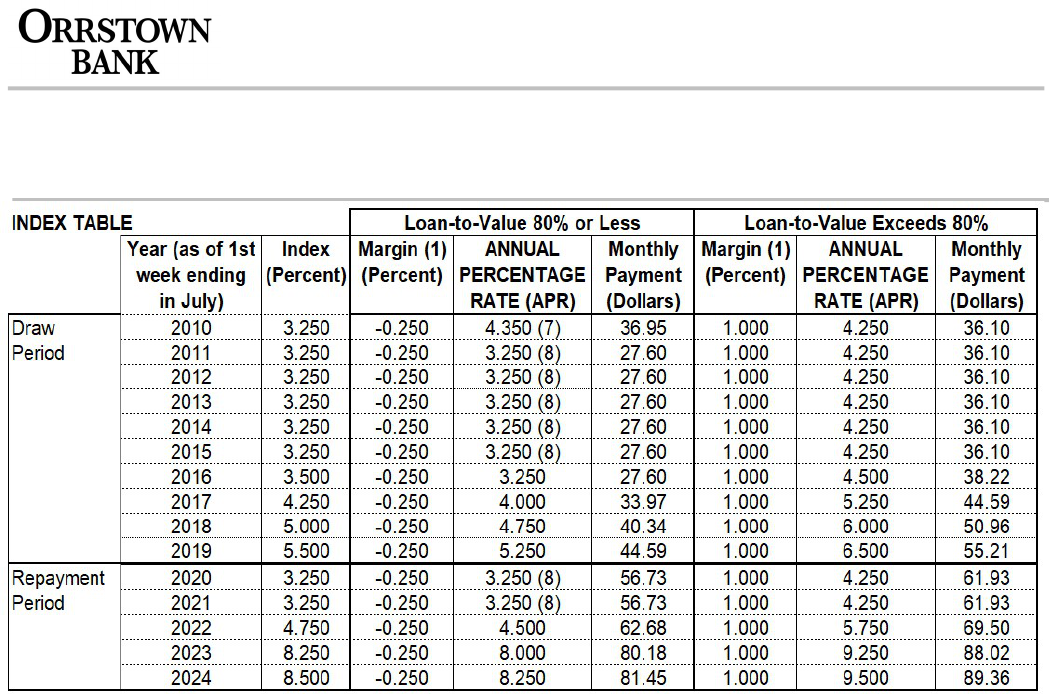
Lender: Orrstown Bank
P O Box 250
Shippensburg, PA 17257
Home Equity Application Disclosure
(1) This is a margin we have used recently; your margin may be different.
(7) This ANNUAL PERCENTAGE RATE reflects a discount that we have provided recently; your Plan may be dicounted by a different amount.
(8) This A.P.R. reflects a 3.250 percent floor.
LASER PRO Lending, Ver. 18.1.0 Copr. Harland Financial Solutions, Inc. 1997, 2013. All Rights Reserved. - PA c:\CFI\LPL\B11.FC PR-271 (M)
MF rev. 07/15/24

Lender: Orrstown Bank
P O Box 250
Shippensburg, PA 17257
Home Equity Application Disclosure
IMPORTANT TERMS OF OUR HOME EQUITY APPLICATION DISCLOSURE
This disclosure contains important information about our MD SmartLock Interest Only Home Equity Line of Credit (the "Plan"). You
should read it carefully and keep a copy for your records.
AVAILABILITY OF TERMS. All of the terms of the Plan described herein are subject to change. If any of these terms change (other than the
ANNUAL PERCENTAGE RATE) and you decide, as a result, not to enter into an agreement with us, you are entitled to a re
fund of any fees that
you paid to us or anyone else in connection with your application.
SECURITY INTEREST. We will take a security interest in your home. You could lose your home if you do not meet the obligations in your
agreement with us.
POSSIBLE ACTIONS. Under this Plan, we have the following rights:
Termination and Acceleration. We can terminate the Plan and require you to pay us the entire outstanding balance in one payment,
and charge you certain fees, if any of the following happens:
(a)
You commit fraud or make a material misrepresentation at any time in connection with the Plan. This can include, for example,
a false statement about your income, assets, liabilities, or any other aspect of your financial condition.
(b)
You do not meet the repayment terms of the Plan.
(c)
Your action or inaction adversely affects the collateral for the Plan or our rights in the collateral. This can include, for example,
failure to maintain required insurance, waste or destructive use of the dwelling, failure to pay taxes
, death of all persons liable on
the account, transfer of title or sale of the dwelling, creation of a senior lien on the dwelling without our permission, foreclosure
by the holder of another lien or the use of funds or the dwelling for prohibited purposes.
Suspension or Reduction. In addition to any other rights we may have, we can suspend additional extensions of credit or reduce your
credit limit during any period in which any of the following are in effect:
(a)
The value of your dwelling declines significantly below the dwelling's appraised value for purposes of the Plan. This includes,
for example, a decline such that the initial difference between the credit limit and the available equity is reduced by fifty percent
and may include a smaller decline depending on the individual circumstances.
(b)
We reasonably believe that you will be unable to fulfill your payment obligations under the Plan due to a material change in
your
financial circumstances.
(c)
You are in default under any material obligation of the Plan. We consider all of your obligations to be material. Categories of
material obligations include, but are not limited to, the events described above under Termination and Acceleration , obligations
to pay fees and charges, obligations and limitations on the receipt of credit advances, obligations concerning maintenance or
use of the dwelling or proceeds, obligations to pay and perform the terms of any other deed of trust, mortgage or lease of the
dwelling, obligations to notify us and to provide documents or information to us (such as updated financial information),
obligations to comply with applicable laws (such as zoning restrictions).
(d)
We are precluded by government action from imposing the annual percentage rate provided for under the Plan.
(e)
The priority
of our security interest is adversely affected by government action to the extent that the value of the security interest
is less than 120 percent of the credit limit.
(f)
We have been notified by governmental authority that continued advances may constitute an unsafe and unsound business
practice.
(g)
The maximum annual percentage rate under the Plan is reached.
Change in Terms. We may make changes to the terms of the Plan if you agree to the change in writing at that time , if the change will
unequivocally benefit you throughout the remainder of the Plan, or if the change is insignificant (such as changes relating to our data
processing systems).
Fees and Charges. In order to open and maintain an account, you must pay certain fees and charges.
Lender Fees. The following fees must be paid to us:
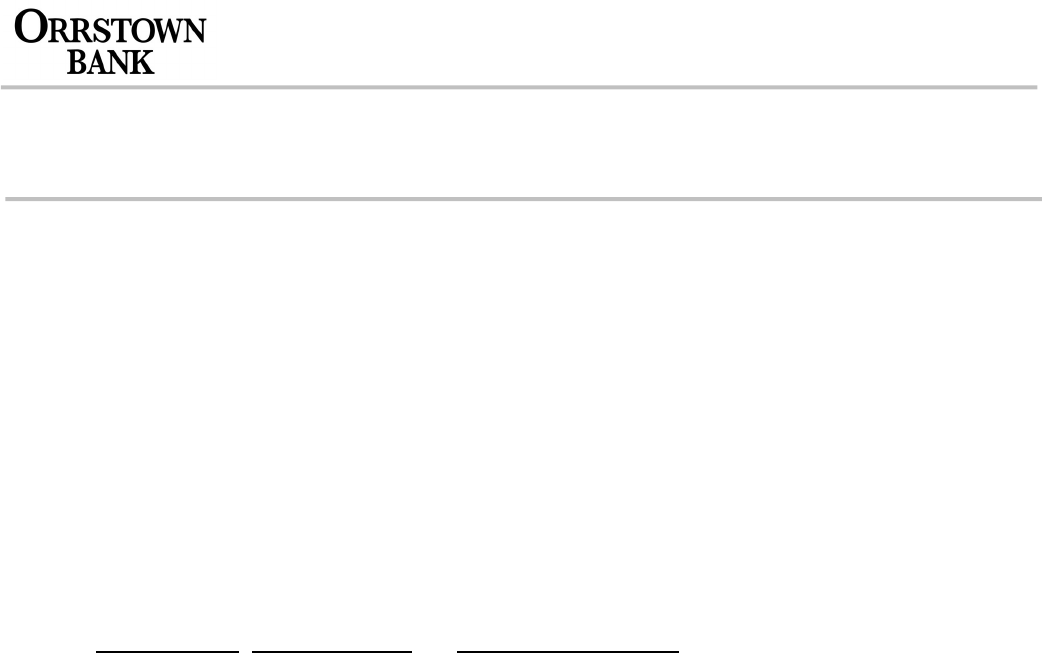
Lender: Orrstown Bank
P O Box 250
Shippensburg, PA 17257
Home Equity Application Disclosure
Recapture Fee: If you elect or request to terminate or close the Credit Line within twenty-four (24) months of the Opening Date, you
may be required to remit any closing costs Orrstown Bank paid on your behalf, including but not limited to recordation taxes.
Late Charge. Your payment will be late if it is not received by us within 16 days after the "Payment Due Date" shown on your
periodic statement. If your payment is late we may charge you 10.000% of the payment or $5.00, whichever is greater.
Third Party Fees. If you are purchasing a property that will also secure the Credit Line, you must pay certain fees to third parties
such as appraisers, credit reporting firms, and government agencies. These third party fees generally total between $300.00 and
$4,580.00 (
for a Credit Line amount of $100,000.00). Upon request, we will provide you with an itemization of the fees you have to pay
to third parties.
PROPERTY INSURANCE. You must carry insurance on the property that secures the Plan.
MINIMUM PAYMENT REQUIREMENTS. You can obtain advances of credit during the following period: for a period of ten years from the
Opening Date. You may however begin the amortization period sooner than ten years, which would discontinue your draw period at that time
(the "Draw Period"). After the Draw Period ends, the repayment period will begin. You will no longer be able to obtain credit advances. The
length of the repayment period is as follows: for a period of twenty years. Your Regular Payment will equal the amount of your accrued
FINANCE CHARGES ("First Payment Stream"). You will make 120 of these payments. Your payments will be due monthly. Your "Minimum
Payment" will be the Regular Payment, plus any amount past due and all other charges. An increase in the ANNUAL PERCENTAGE RATE
may increase the amount of your Regular Payment. The Minimum Payment during the First Payment Stream will not reduce the principal that is
outstanding on your Credit Line.
After completion of the First Payment Stream, your Regular Payment will be based on an amortization of your balance at the st
art of this
payment period as shown below (“Second Payment Stream”). Your payments will be due monthly.
Range of Balances Number of Payments Regular Payment Calculation
All Balances
240 240 payments
Your "Minimum Payment" will be the Regular Payment, plus any amount past due and all other charges.
A change in the ANNUAL PERCENTAGE RATE can cause the balance to be repaid more quickly or more slowly. When rates decrease, l
ess
interest is due, so more of the payment repays the principal balance. When rates increase, more interest is due, so less of the payment repays
the principal balance. If this happens, we may adjust your payment as follows: your payment may be increased by the amount necessary to
repay the balance by the end of this payment stream. Each time the ANNUAL PERCENTAGE RATE changes, we will review the effect the
change has on your Credit Line Account to see if your payment is sufficient to pay the balance by the Maturity Date. If it is
not, your payment will
be increased by an amount necessary to repay the balance by the Maturity Date.
MINIMUM PAYMENT EXAMPLE.
Loan-to-Value 80% or Less: If you made only the minimum payment and took no other credit advances, it would take 30 years to pay off
a credit advance of $10,000.00 at an ANNUAL PERCENTAGE RATE of 8.50%. During that period, you would make 120 monthly
payments ranging from $65.21 to $72.19. Then you would make 240 monthly payments ranging from $86.80 to 88.25
. We have used this
rate of 8.50% recently on Credit Lines less than $100,000.00.
Loan-to-Value Exceeds 80%: If you made only the minimum payment and took no other credit advances, it would take 30 years to pay
off a credit advance of $10,000.00 at an ANNUAL PERCENTAGE RATE of 9.75%. During that period, you would make 120 monthly
payments ranging from $74.79 to $82.81. Then you would make 240 monthly payments ranging from $94.87 to $97.87.
TRANSACTION REQUIREMENTS. The following transaction limitations will apply to the use of your Credit Line:
Credit Line Credit Line Check Limitations. The following transaction limitations will apply to your Credit Line and the writing of Credit
Line Checks.
Maximum Number of Advances Per Period. The maximum number of advances that you may obtain per month is 10.
Minimum Advance Amount. The minimum amount of any credit advance that can be made on your Credit Line is $100.00. This
means any Credit Line Check must be written for at least the minimum advance amount.
Telephone Request Limitations. The following transaction limitations will apply to your Credit Line and requesting an advance by
telephone.
Maximum Number of Advances Per Period. The maximum number of advances that you may obtain per month is 10.
Minimum Advance Amount. The minimum amount of any credit advance that can be made on your Credit Line is $100.00.
Overdraft Limitations. The following transaction limitations will apply to your Credit Line and writing a check in excess of your checking
account balance.
Maximum Number of Advances Per Period. The maximum number of advances that you may obtain per month is 20.
Minimum Advance Amount. The minimum amount of any credit advance that can be made on your Credit Line is $50.00.
Other Transaction Requirements. If the credit line balance is less than $50.00, and the overdraft is less than $50.00, the amount of the
overdraft will be taken.
In Person Request Limitations. The following transaction limitations will apply to your Credit Line and requesting an advance in person.
Maximum Number of Advances Per Period. The maximum number of advances that you may obtain per month is 10.
Minimum Advance Amount. The minimum amount of any credit advance that can be made on your Credit Line is $100.00.

Lender: Orrstown Bank
P O Box 250
Shippensburg, PA 17257
Home Equity Application Disclosure
Internet Banking Limitations. The following transaction limitations will apply to your Credit Line and accessing by other methods.
Maximum Number of Advances Per Period. The maximum number of advances that you may obtain per month is 10.
Minimum Advance Amount.
The minimum
amount of any credit advance that can be made on your Credit Line is $100.00.
CONVERSION OPTION.
This agreement contains an option to convert a portion or all of the balance under your Credit Line from a variable
ANNUAL PERCENTAGE RATE to a fixed
ANNUAL PERCENTAGE RATE as determined below. Each portion of the balance under your
Credit Line you convert to a fixed ANNUAL
PERCENTAGE RATE is referred to as a “Fixed-Rate Advance.” The following information describes the terms and features of the conversion
option available under this Agreement:
ANNUAL PERCENTAGE RATE Increase. Your ANNUAL PERCENTAGE RATE may increase if you exercise this option to convert
to a fixed rate.
Conversion Periods. You can exercise the option to convert to a fixed rate only during the following period or periods: You can
exercise the option to convert to a fixed ANNUAL PERCENTAGE RATE at any time during the Draw Period, and any extension of the Draw
Period. After the Draw Period ends, or if you do not meet the repayment terms of this credit agreement, you will not be able to exercise the
option to convert to a fixed ANNUAL PERCENTAGE RATE.
Conversion Fees. You will be required to pay the following fees at the time of the conversion to a fixed rate: a rate lock fee of
$50.00 each time you exercise the option to convert to a fixed ANNUAL PERCENTAGE RATE. This is a FINANCE CHARGE. You will be
required to pay a rate unlock fee of $75.00 each time you exercise the option to convert to a variable ANNUAL PERCENTAGE RATE. This is a
FINANCE CHARGE.
Rate Determination: The fixed rate will be determined as follows: The fixed rate will be based on certain credit criteria and length of
the fixed rate term, in conjunction with our published rates for a closed-end home equity loan at the time of the conversion request.
Conversion Rules. You can convert to
a fixed rate only during the period or periods described above. In addition, the following rules
apply to the conversion option under this agreement: You can exercise the option to convert to a fixed ANNUAL PERCENTAGE RATE only
during the period or periods described above. The minimum fixed rate advance is $5,000.00.
(a) Minimum and maximum term. If you exercise the option to convert to a fixed ANNUAL PERCENTAGE RATE, the term of the Fixed-
Rate Advance cannot be less than twelve (12) months or longer than two hundred and forty (240) months.
(b) Number of Fixed-Rate Advances. You can exercise the option to convert to a fixed ANNUAL PERCENTAGE RATE from time to time,
but you may not have more than five (5) different Fixed Rate Advances outstanding under your Credit Line Account at any one time.
(c) Ineligible for Promotional Rates. In determining your interest rate and ANNUAL PERCENTAGE RATE as described in the Rate
Determination paragraph above, our published closed-end home equity loan interest rates and ANNUAL PERCENTAGE RATE will not
include any special, promotion or coupon interest rates and interest rates available only for newly opened accounts. If we offer a
discounted interest rate and ANNUAL PERCENTAGE RATE for agreeing to make payments through automatic deduction from a
checking account maintained with us, that discounted rate will be considered the published rate for purposes of the Rate Determination
paragraph above, only if you have agreed to have payments under your Credit Line Account automatically deducted from a checking
account you maintain with us.
(d) Complete Election Form. In order to exercise the option to convert to a fixed ANNUAL PERCENTAGE RATE, you must complete the
SmartLock Rate Lock Request Form.
(e) Minimum Monthly Payments. At the time you exercise the option to convert to a fixed ANNUAL PERCENTAGE RATE, we will
determine a minimum monthly payment applicable to that Fixed-Rate Advance. The minimum monthly payment will include both
principal and interest and will be sufficient to repay the Fixed Rate Advance in equal monthly installments of principal and interest over
the term of the Fixed Rate Advance. The minimum monthly payment with respect to a Fixed-
Rate Advance will not be less than $50.00.
If you have more than one Fixed-Rate Advance outstanding, you will have to make minimum monthly payments with respect to each
Fixed Rate Advance. The minimum monthly payments due with respect to Fixed Rate Advances will be in addition to the Minimum
Payment due with respect to any balance under your Credit Line subject to a variable ANNUAL PERCENTAGE RATE.
(f) How Payments Are Applied If You Have A Fixed-Rate Advance Outstanding. Separate billing will be provided for each Fixed-Rate
Advance. Payments include principal and interest. Unless otherwise agreed or required by applicable law, payments will be applied
first to any accrued unpaid interest; then to principal; then to any late charges; and then to any unpaid collection costs.
In the event you
make a payment in excess of the amount necessary to pay all of these amounts, the excess will be first applied to reduce any principal
outstanding. Any prepayments of principal will not reduce the amount of, or extend the due date for, any future minimum monthly
payments.
(g) Unlock Requirement. The fixed rate por
tion must be in effect for a minimum of 365 days before you can exercise your option to convert
the fixed rate portion into a variable rate. You will need to execute the SmartLock Rate Unlock Request Form to convert back to a
variable rate feature after the 365 day fixed rate period, if desired.

Lender: Orrstown Bank
P O Box 250
Shippensburg, PA 17257
Home Equity Application Disclosure
TAX DEDUCTIBILITY. You should consult a tax advisor regarding the deductibility of interest and charges for the Plan.
ADDITIONAL HOME EQUITY PROGRAMS. Please ask us about our other available Home Equity Line of Credit plans.
VARIABLE RATE FEATURE. The Plan has a variable rate feature. The ANNUAL PERCENTAGE RATE (corresponding to the periodic rate),
and the minimum payment amount can change as a result. The ANNUAL PERCENTAGE RATE does not include costs other than interest.
THE INDEX. The annual percentage rate is based on the value of an index (referred to in this disclosure as the "Index"). The Index is the Wall
Street Prime. Information about the Index is available or published in the Wall Street Journal. We will use the most recent Index value available
to us as of the date of any annual percentage rate adjustment. If the Index is no longer available, we will choose a new Index and margin. The
new Index will have an historical movement substantially similar to the original Index, and the new Index and margin will result in an annual
percentage rate that is substantially similar to the rate in effect at the time the original Index becomes unavailable.
ANNUAL PERCENTAGE RATE. To determine the Periodic Rate that will apply to your First Payment Stream , we add a margin to the value of
the Index, round that sum up to the nearest 0.125%, then divide the rounded value by the number of days in a year (daily). To obtain the
ANNUAL
PERCENTAGE RATE we multiply the Periodic Rate by the number of days in a year (daily). This result is the ANNUAL PERCENTAGE
RATE for your First Payment Stream. To determine the Periodic Rate that will apply to your Second Payment Stream , we add a margin to the
value of the Index, round that sum up to the nearest 0.125%, then divide the rounded value by the number of days in a year (d
aily). To obtain the
ANNUAL PERCENTAGE RATE we multiply the Periodic Rate by the number of days i
n a year (daily). This result is the ANNUAL PERCENTAGE
RATE for your Second Payment Stream. A change in the Index rate generally will result in a change in the ANNUAL PERCENTAGE RATE. The
amount that your ANNUAL PERCENTAGE RATE may change also may be affected by the lifetime annual percentage rate limits, as discussed
below.
Initial ANNUAL PERCENTAGE RATE Discount. The initial ANNUAL PERCENTAGE RATE is “discounted” – it is not based on the
Index and margin used for later rate adjustments. The initial discounted rate will be in effect for six (6) months. The interest rate of
4.35% will be calculated and in effect for 6 months from the original date of the Credit Agreement and Disclosure. Offer valid ONLY on
new SmartLock customers. Additional credit score and loan-to-value restrictions may apply which may impact the initial annual
percentage rate.
Please ask us for the current Index value, margin, discount and annual percentage rate. After you open a credit line, rate information
will be provided on periodic statements that we send to you.
PREFERRED VARIABLE RATE. The ANNUAL PERCENTAGE RATE under the Plan may include a preferred variable rate which is subject to
the following rules and provisions:
Description of Event That Would Cause Lender to Increase the ANNUAL PERCENTAGE RATE. Automatic drafting of payment
from an Orrstown Bank checking or savings account is discontinued.
How The New Rate Will Be Determined. As determined above, the ANNUAL PERCENTAGE RATE under this Plan is variable based
on the Index value plus a margin. Should the event described above occur, the ANNUAL PERCENTAGE RATE will be increased as
follows: by adding 0.75% to the current rate.
FREQUENCY OF ANNUAL PERCENTAGE RATE ADJUSTMENTS. Your ANNUAL PERCENTAGE RATE can change quarterly. There is no
limit on the amount by which the annual percentage rate can change during any one year period. However, under no circumstances will your
ANNUAL PERCENTAGE RATE exceed 18.000% per annum or, except for any initial discount period, go below
3.250% per annum at any time
during the term of the Plan.
MAXIMUM RATE AND PAYMENT EXAMPLE.
Draw Period. If you had an outstanding balance of $10,000.00, the minimum payment at the maximum ANNUAL PERCENTAGE RATE of
18.000% would be $152.88. This ANNUAL PERCENTAGE RATE could be reached at the time of the 1st payment.
Repayment Period. If you had an outstanding balance of $10,000.00, the minimum payment at the maximum ANNUAL PERCENTAGE
RATE of 18.000% would be $154.36. This ANNUAL PERCENTAGE RATE could be reached at the time of the 1st payment during the
repayment period.
PREPAYMENT. You may prepay all or any amount owing under the Plan at any time without penalty.
HISTORICAL EXAMPLE. The examples below show how the ANNUAL PERCENTAGE RATE and the minimum payments for a single
$10,000.00 credit advance would have changed based on changes in the Index from 2010 to 2024. The Index values are from the following
reference period: as of 1st week ending in July. While only one payment per year is shown, payments may have varied during each year.
Different outstanding principal balances could result in different payment amounts.
The table assumes that no additional credit advances were taken, that only the minimum payments were made, and that the rate remained
constant during the year. It does not necessarily indicate how the Index or your payments would change in the future.
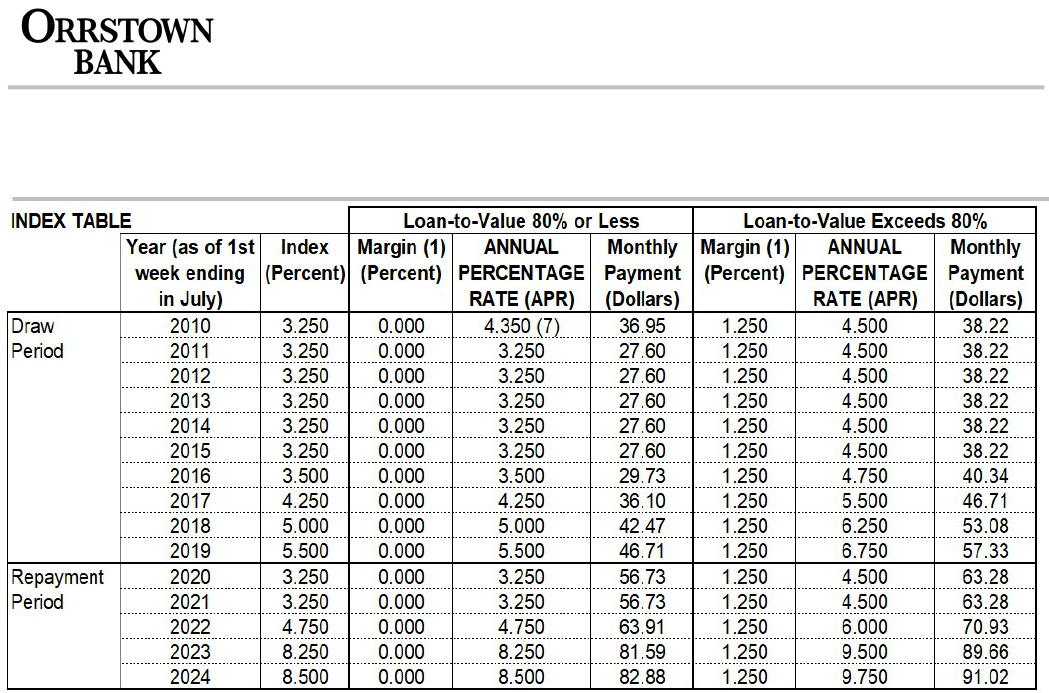
Lender: Orrstown Bank
P O Box 250
Shippensburg, PA 17257
Home Equity Application Disclosure
(1) This is a margin we have used recently; your margin may be different.
(7) This ANNUAL PERCENTAGE RATE reflects a discount that we have provided recently; your Plan may be discounted by a different amount.
LASER PRO Lending, Ver. 17.1.10 Copr. Harland Financial Solutions, Inc. 1997, 2013. All Rights Reserved. - PA c:\CFI\LPL\B11.FC PR-271 (M)
MF rev. 07/15/24
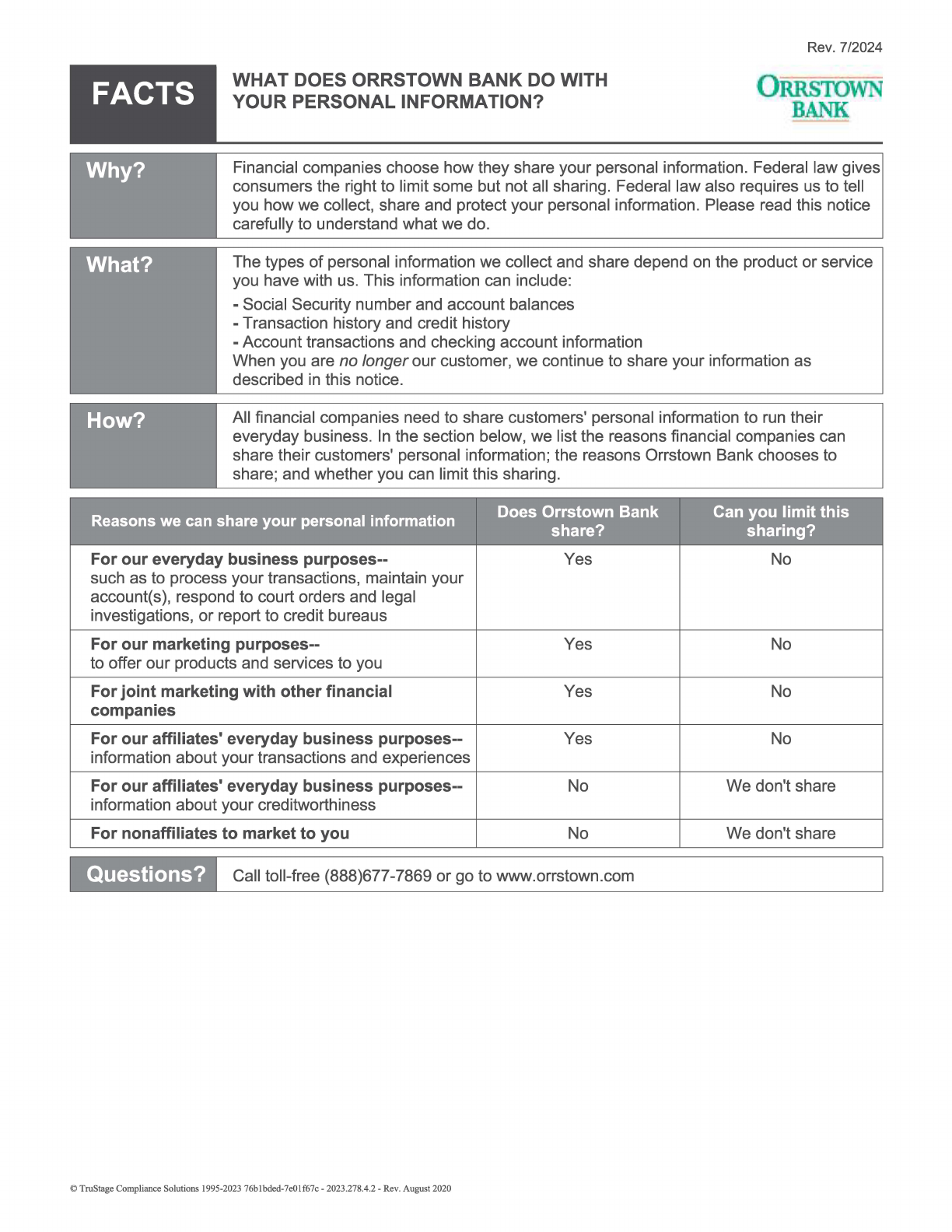
FACTS
WHAT DOES ORRSTOWN BANK DO WITH
YOUR PERSONAL INFORMATION?
Rev. 7/2024
OiffisroWN
BANK
Why?
Financial companies choose how they share your personal information. Federal law gives
consumers the right to limit some but not all sharing. Federal law also requires us to tell
you how we collect, share and protect your personal information. Please read this notice
carefully to understand what we do.
The types
of
personal information we collect and share depend on the product or service
you have with us. This information can include:
- Social Security number and account balances
- Transaction history and credit history
- Account transactions and checking account information
When you are no longer our customer, we continue to share your information as
described
in
this notice.
How?
All financial companies need to share customers' personal information to run their
everyday business.
In
the section below, we list the reasons financial companies can
share their customers' personal information; the reasons Orrstown Bank chooses to
share; and whether you can limit this sharing.
Reasons
we
can
share your personal information
Does Orrstown Bank Can you limit this
share? sharing?
For our everyday business purposes--
Yes No
such as to process your transactions, maintain your
account(s), respond to court orders and legal
investigations, or report to credit bureaus
For our marketing purposes-- Yes No
to offer our products and services to you
For joint marketing with other financial Yes No
companies
For our affiliates' everyday business purposes--
Yes No
information about your transactions and experiences
For our affiliates' everyday business purposes--
No
We don't share
information about your creditworthiness
For nonaffiliates to market to you No We don't share
Questions?
Call toll-free (888)677-7869 or go to www.orrstown.com
© TruStage Compliance Solutions 1995-2023 76blbded-7e0lf67c- 2023.278.4.2 - Rev. August 2020
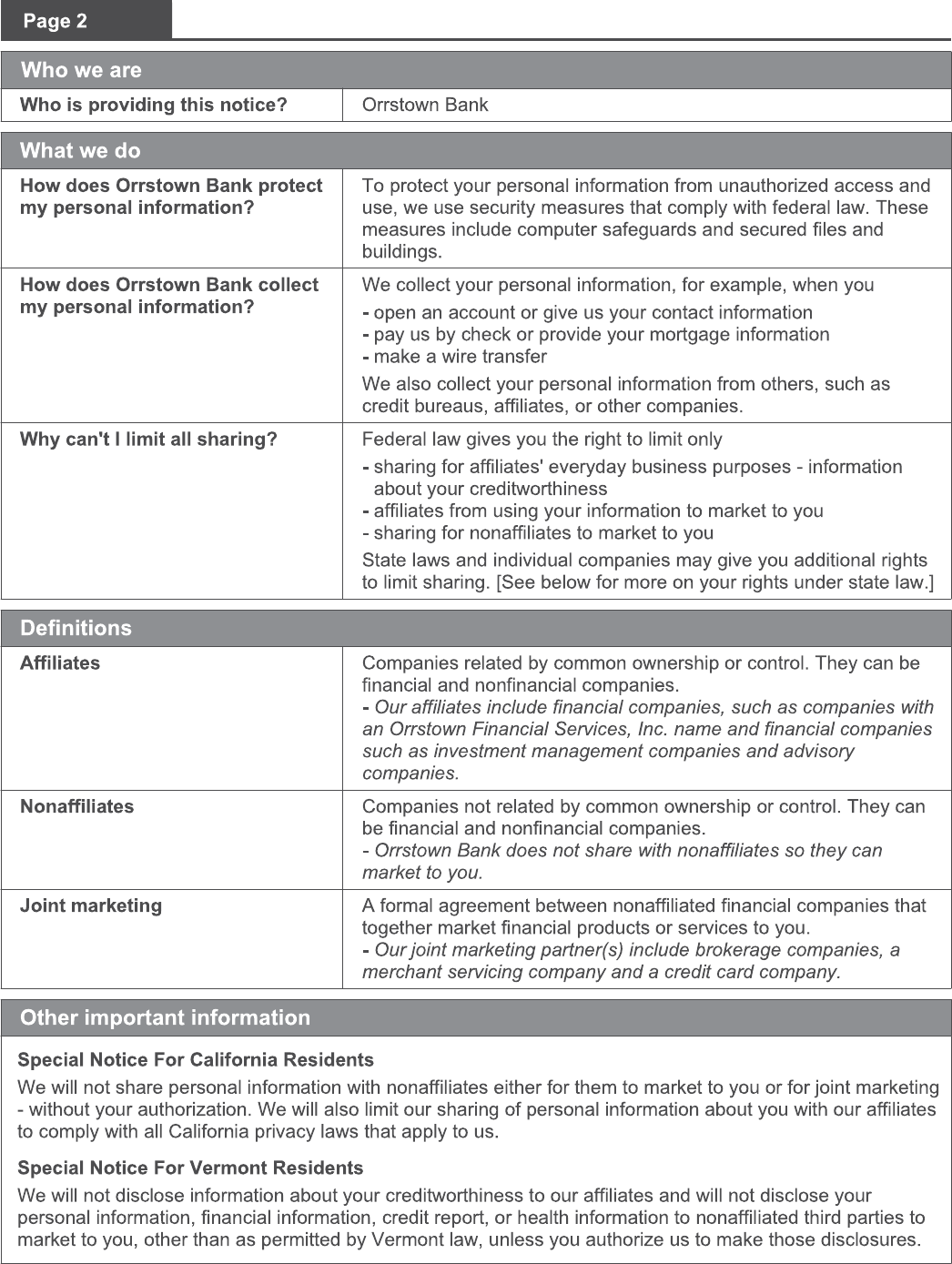
What we do
How does Orrstown Bank protect
my personal information?
How does Orrstown Bank collect
my personal information?
Why can't I limit all sharing?
Definitions
Affiliates
Nonaffiliates
Joint marketing
Other important information
To protect your personal information from unauthorized access and
use, we use security measures that comply with federal law. These
measures include computer safeguards and secured files and
buildings.
We collect your personal information, for example, when you
- open
an
account or give us your contact information
- pay us by check or provide your mortgage information
- make a wire transfer
We also collect your personal information from others, such as
credit bureaus, affiliates, or other companies.
Federal law gives you the right to limit only
- sharing for affiliates' everyday business purposes - information
about your creditworthiness
- affiliates from using your information to market to you
- sharing for nonaffiliates to market to you
State laws and individual companies may give you additional rights
to limit sharing. [See below for more on your rights under state law.]
Companies related by common ownership or control. They can be
financial and nonfinancial companies.
- Our affiliates include financial companies, such as companies with
an Orrstown Financial Services, Inc. name and financial companies
such as investment management companies and advisory
companies.
Companies not related by common ownership or control. They can
be financial and nonfinanci
al
companies.
- Orrstown Bank does not share with nonaffiliates so they can
market to you.
A formal agreement between nonaffiliated financial companies that
together market financial products
or
services to you.
- Our joint marketing partner(s) include brokerage companies, a
merchant servicing company and a credit card company.
Special Notice For California Residents
We will not share personal information with nonaffiliates either for them to market to you or for joint marketing
- without your authorization. We will also limit our sharing
of
personal information about you with our affiliates
to comply with all California privacy laws that apply to us.
Special Notice For Vermont Residents
We will not disclose information about your creditworthiness to our affiliates and will not disclose your
personal information, financial information, credit report,
or
health information to nonaffiliated third parties to
market to you, other than as permitted by Vermont law, unless you authorize us to make those disclosures.
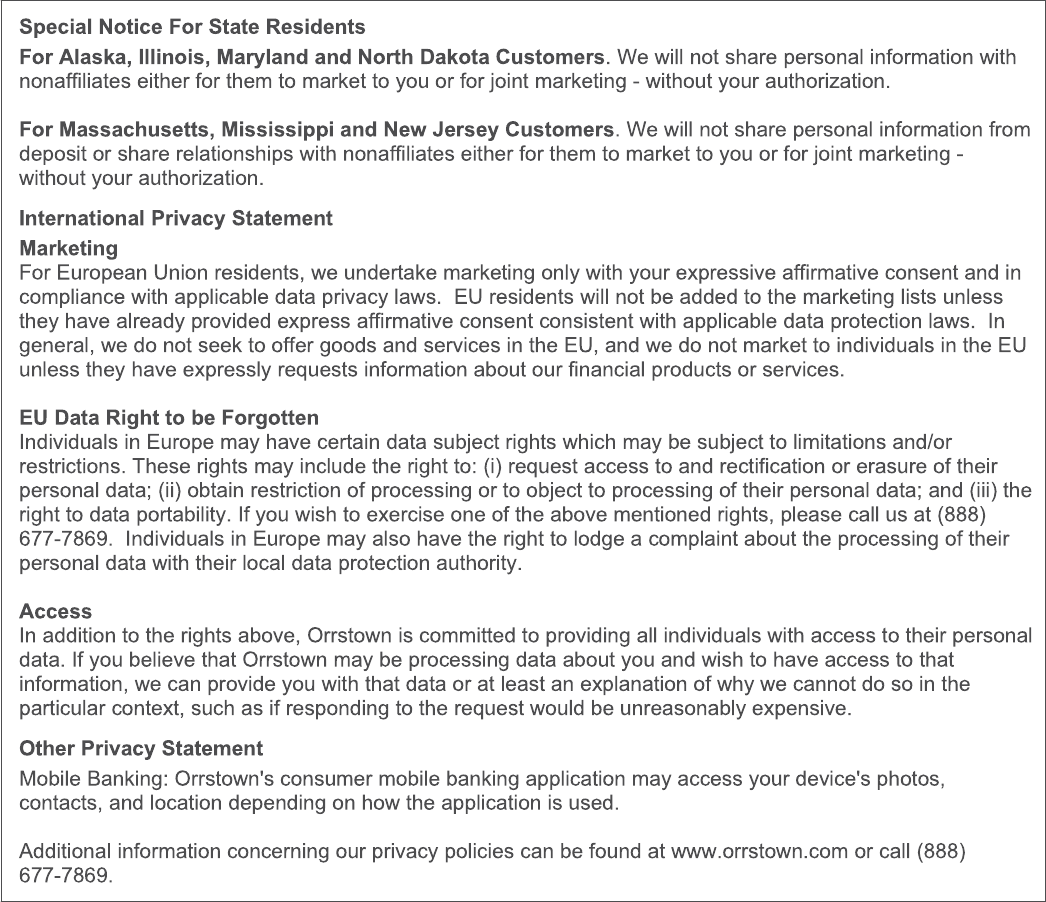
Special Notice For State Residents
For Alaska, Illinois, Maryland and North Dakota Customers. We will not share personal information with
nonaffiliates either for them to market to you or for joint marketing - without your authorization.
For Massachusetts, Mississippi and New Jersey Customers. We will not share personal information from
deposit or share relationships with nonaffiliates either for them to market to you
or
for joint marketing -
without your authorization.
International Privacy Statement
Marketing
For European Union residents, we undertake marketing only with your expressive affirmative consent and
in
compliance with applicable data privacy laws.
EU
residents will not
be
added to the marketing lists unless
they have already provided express affirmative consent consistent with applicable data protection laws.
In
general, we do not seek to offer goods and services in the
EU
, and we do not market to individuals
in
the
EU
unless they have expressly requests information about our financial products or services.
EU
Data Right to be Forgotten
Individuals
in
Europe may have certain data subject rights which may be subject to limitations and/or
restrictions. These rights may include the right to: (i) request access to and rectification or erasure
of
their
personal data; (ii) obtain restriction
of
processing or to object to processing of their personal data; and (iii) the
right to data portability. If you wish to exercise one
of
the above mentioned rights, please call us at (888)
677-7869. Individuals
in
Europe may also have the right to lodge a complaint about the processing
of
their
personal data with their local data protection authority.
Access
In
addition to the rights above, Orrstown is committed to providing all individuals with access to their personal
data. If you believe that Orrstown may be processing data about you and wish to have access to that
information, we can provide you with that data or at least an explanation
of
why we cannot do so
in
the
particular context, such as
if
responding to the request would be unreasonably expensive.
Other Privacy Statement
Mobile Banking: Orrstown's consumer mobile banking application may access your device's photos,
contacts, and location depending on how the application is used.
Additional information concerning our privacy policies can be found at www.orrstown.com or call (888)
677-7869.

WHAT YOU SHOULD KNOW ABOUT
Home Equity
Lines of Credit
(HELOC)
Borrowing from the
value of your home
Consumer Financial
Protection Bureau
An ofcial publication of the U.S. government

How to use the booklet
When you and your lender discuss home equity
lines of credit, often referred to as HELOCs,
you receive a copy of this booklet. It helps you
explore and understand your options when
borrowing against the equity in your home.
You can nd more information from the
Consumer Financial Protection Bureau (CFPB)
about home loans at cfpb.gov/mortgages.
You’ll also nd other mortgage-related CFPB
resources, facts, and tools to help you take
control of your borrowing options.
About the CFPB
The CFPB is a 21st century agency that
implements and enforces federal consumer
nancial law and ensures that markets for
consumer nancial products are fair, transparent,
and competitive.
This pamphlet, titled What you should know about
home equity lines of credit, was created to comply with
federal law pursuant to 15 U.S.C. 1637a(e) and 12 CFR
1026.40(e).
How can this booklet help you?
This booklet can help you decide whether
home equity line of credit is the right choice
for you, and help you shop for the best
available option.
A home equity line of credit (HELOC) is
a loan that allows you to borrow, spend,
and repay as you go, using your home as
collateral.
Typically, you can borrow up to a
specied percentage of your equity.
Equity is the value of your home minus
the amount you owe on your mortgage.
Consider a HELOC if you are condent
you can keep up with the loan
payments. If you fall behind or can’t
repay the loan on schedule, you could
lose your home.
After you nish this booklet:
• You’ll understand the effect of borrowing
against your home
• You’ll think through your borrowing and
nancing options, besides a HELOC
• You’ll see how to shop for your best HELOC
offer
• You’ll see what to do if the economy or your
situation changes
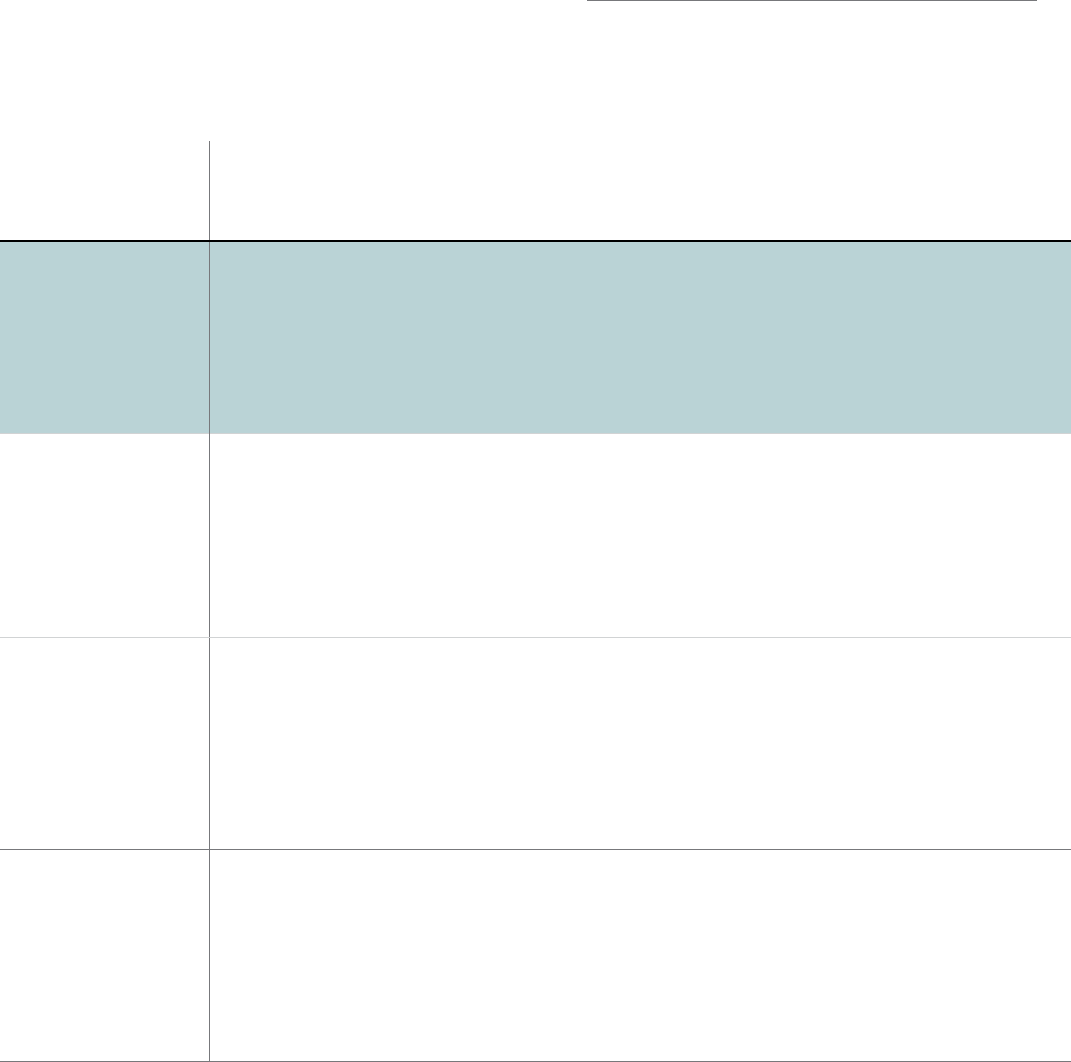
TIP
Renting your home out to other people may be
prohibited under the terms of your line of credit.
Compare a HELOC to other
money sources
Before you decide to take out a HELOC, it might
make sense to consider other options that might
be available to you, like the ones below.
VARIABLE IS YOUR
HOW MUCH CAN YOU TYPICAL TYPICAL
MONEY SOURCE
OR FIXED HOME AT
BORROW ADVANTAGES DISADVANTAGES
RATE RISK?
SECOND
Generally a
Fixed Yes Equal payments If you need more
percentage of the
that pay off the money, you need to
MORTGAGE OR
appraised value
entire loan apply for a new loan;
of your home,
repayment is often
HOME EQUITY
LOAN
minus the amount
required when you
You borrow against
you owe on your
sell your home
the equity in your
mortgage
home
CASH-OUT
Generally a
Variable Yes Continue to make Closing costs are
REFINANCE
percentage of the
or xed just one mortgage generally higher;
appraised value
payment it may take longer
You replace your
of your home; the
to pay off your
amount of your
mortgage; interest
existing mortgage
with a bigger
existing loan plus
rate may be higher
mortgage and take
the amount you
than your current
the difference in cash
want to cash out
mortgage
PERSONAL LINE OF
Up to your Variable, No Continue repaying
Solid credit is
CREDIT
credit limit, as typically and borrowing
required; you may
determined by the for several years
need to pay the
You borrow based on
lender without additional
entire amount due
approvals or
once a year; higher
your credit, without
using your home as
paperwork
interest rate than a
collateral
loan that uses your
home as collateral
HELOC
You borrow against
the equity in your
home
percentage of the
appraised value
of your home,
minus the amount
you owe on your
mortgage
typically
Generally a
Variable. Yes Continue
repaying and
Repayment amount
borrowing for
several years
often required when
without additional
approvals or
paperwork
varies; repayment is
you sell your home
2 HOME EQUITY LINES OF CREDIT COMPARE A HELOC TO OTHER MONEY SOURCES 3
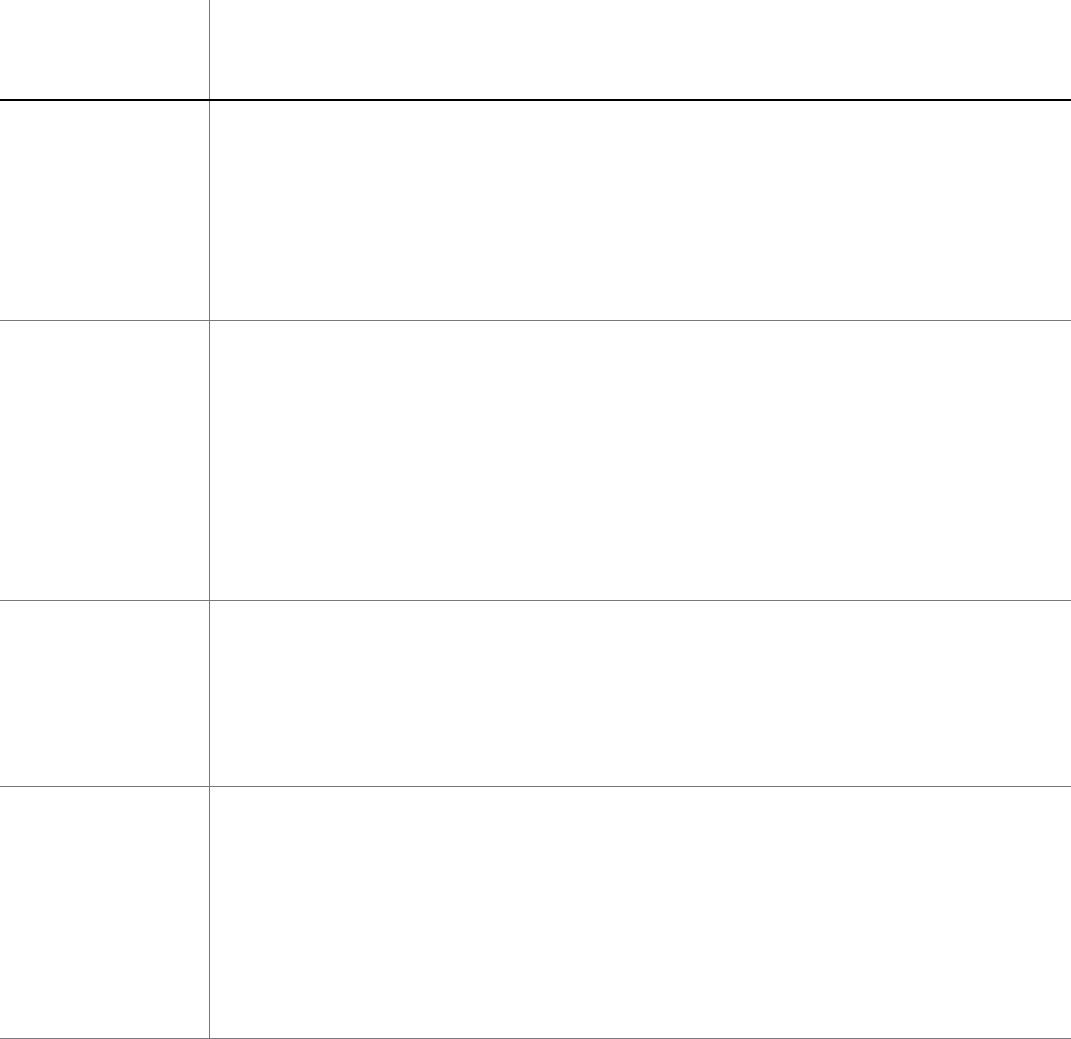
Compare a HELOC to
other money sources
MONEY SOURCE
HOW MUCH CAN YOU
BORROW
VARIABLE
OR FIXED
RATE
IS YOUR
HOME AT
RISK?
TYPICAL
ADVANTAGES
TYPICAL
DISADVANTAGES
RETIREMENT PLAN
Generally, up Fixed No Repay through
If you leave or lose
LOAN
You borrow from your
to 50% of your
vested balance
or $50,000,
paycheck
deductions;
paperwork
your job, repay the
whole amount at
that time or pay
retirement savings
whichever is less required but no
taxes and penalties;
in a 401(k) or similar
credit check and
spouse may need to
plan through your
no impact on your
consent
current employer
credit score
HOME EQUITY
Depends on your Fixed or Yes You don’t make
The amount you owe
CONVERSION
age, the interest variable monthly loan
grows over time;
MORTGAGE (HECM)
You must be age 62
rate on your loan,
and the value of
your home
payments—
instead, you
typically repay the
you might not have
any value left in your
home if you want to
or older, and you
loan when you
leave it to your heirs
borrow against the
move out, or your
equity in your home
survivors repay it
after you die
CREDIT CARD
Up to the amount Fixed or No No minimum
Higher interest rate
You borrow money
of your credit limit, variable purchase;
than a loan that
from the credit card
company and repay
as determined by
the credit card
company
consumer
protections in the
case of fraud or
uses your home as
collateral
as you go
lost or stolen card
FRIENDS AND
Agreed on by Variable, No Reduced waiting Forgiven loans
FAMILY
You borrow money
the borrower and
lender
xed or
other
time, fees, and
paperwork
compared to a
and unreported or
forgiven interest can
complicate taxes,
from someone you
are close to
formal loan especially for large
loans; can jeopardize
important personal
relationships if
something goes
wrong
4 HOME EQUITY LINES OF CREDIT COMPARE A HELOC TO OTHER MONEY SOURCES 5

How HELOCs work
PREPARE FOR UP-FRONT COSTS
Some lenders waive some or all of the up-front
costs for a HELOC. Others may charge fees. For
example, you might get charged:
• A fee for a property appraisal, which is a formal
estimate of the value of your home
• An application fee, which might not be
refunded if you are turned down
• Closing costs, including fees for attorneys,
title search, mortgage preparation and ling,
property and title insurance, and taxes
PULL MONEY FROM YOUR LINE OF CREDIT
Once approved for a HELOC, you can generally
spend up to your credit limit whenever you want.
When your line of credit is open for spending, you
are in the you are in the borrowing period, also
called the draw period. Typically, you use special
checks or a credit card to draw on your line. Some
plans require you to borrow a minimum amount
each time (for example, $300) or keep a minimum
amount outstanding. Some plans require you to
take an initial amount when the credit line is set up.
MAKE REPAYMENTS DURING THE “DRAW
PERIOD”
Some plans set a minimum monthly payment that
includes a portion of the principal (the amount you
borrow) plus accrued interest. The portion of your
payment that goes toward principal typically does
not repay the principal by the end of the term.
Other plans may allow payment of the interest only,
during the draw period, which means that you pay
nothing toward the principal.
If your plan has a variable interest rate, your
monthly payments may change even if you don’t
draw more money.
ENTER THE “REPAYMENT PERIOD”
Whatever your payment arrangements during the
draw period—whether you pay some, a little, or
none of the principal amount of the loan—when the
draw period ends you enter a repayment period.
Your lender may set a schedule so that you repay
the full amount, often over ten or 15 years.
Or, you may have to pay the entire balance owed,
all at once, which might be a large amount called
a balloon payment. You must be prepared to
make this balloon payment by renancing it with
the lender, getting a loan from another lender, or
some other means. If you are unable to pay the
balloon payment in full, you could lose your home.
RENEW OR CLOSE OUT THE LINE OF CREDIT
At the end of the repayment period, your lender
might encourage you to leave the line of credit
open. This way you don’t have to go through the
cost and expense of a new loan, if you expect to
borrow again. Be sure you understand if annual
maintenance fees or other fees apply, even if you
are not actively using the credit line.
TIP
If you sell your home, you are generally required
to pay off your HELOC in full immediately. If you
are likely to sell your home in the near future,
consider whether or not to pay the up-front costs
of setting up a line of credit.
6 HOME EQUITY LINES OF CREDIT HOW HELOCS WORK 7

GET THREE HELOC ESTIMATES
Shopping around lets you compare costs and
features, so you can feel condent you’re making
the best choice for your situation.
OFFER A OFFER B OFFER C
Initiating the HELOC
Credit limit
$
First transaction
$
Minimum transaction
$
Minimum balance
$
Fixed annual percentage rate
Variable annual percentage rate
» Index used and current value
» Amount of margin
» Frequency of rate adjustments
» Amount/length of discount rate (if any)
» Interest rate cap and oor
Length of plan
» Draw period
» Repayment period
Initial fees
» Appraisal fee
$
» Application fee
$
8 HOME EQUITY LINES OF CREDIT GET THREE HELOC ESTIMATES 9
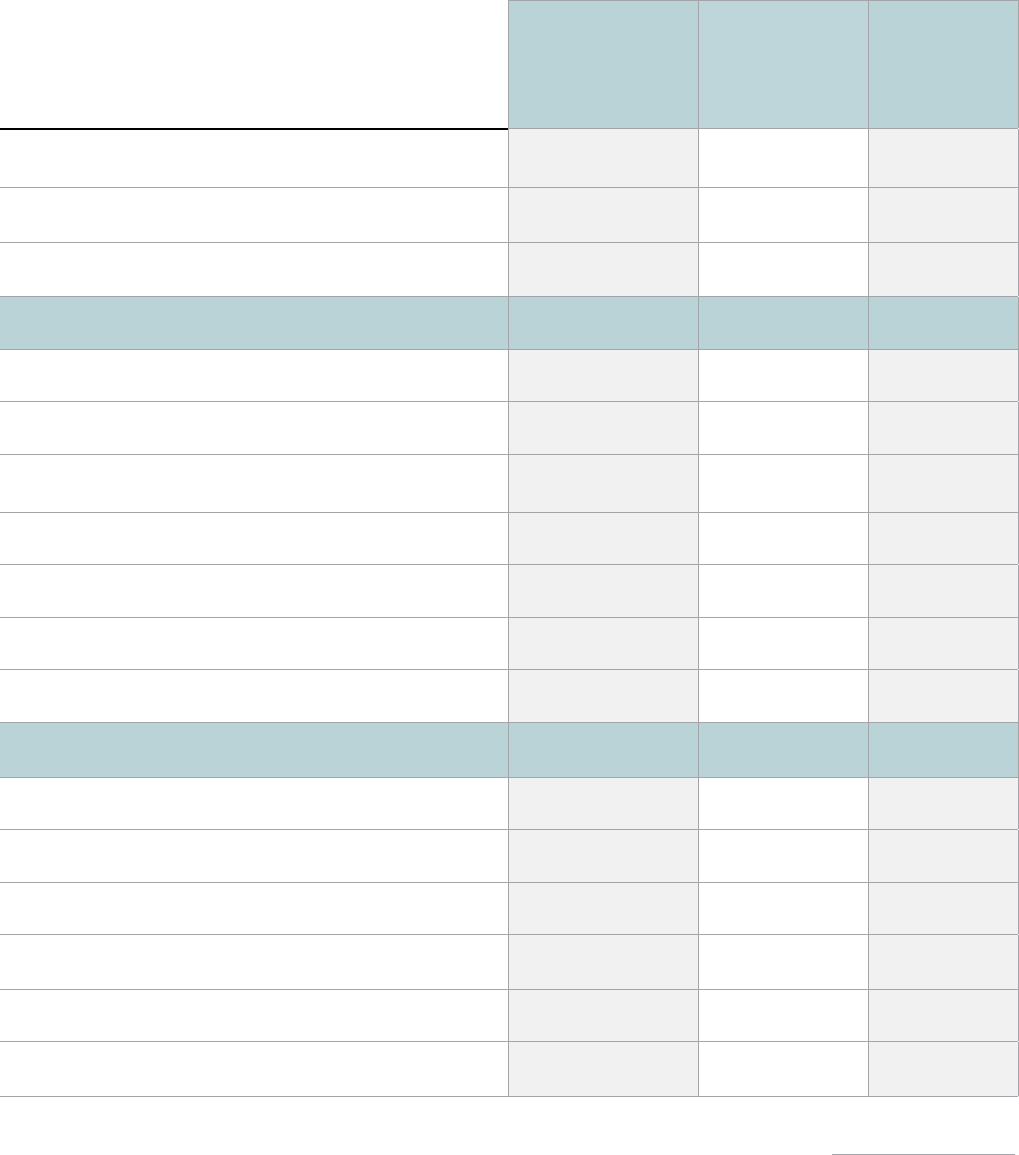
GET THREE HELOC ESTIMATES
Shopping around lets you compare costs and
features, so you can feel condent you’re making the
best choice for your situation.
OFFER A OFFER B OFFER C
» Up-front charges, including points
$
» Early termination fee
$
» Closing costs
During the draw period
» Interest and principal payments
$
» Interest-only payments?
$
» Fully amortizing payments
$
» Annual fee (if applicable)
$
» Transaction fee (if applicable)
$
» Inactivity fee
$
» Prepayment and other penalty fees
$
During the repayment period
» Penalty for overpayments?
» Fully amortizing payment amount?
» Balloon repayment of full balance owed?
» Renewal available?
» Renancing of balance by lender?
» Conversion to xed-term loan?
10 HOME EQUITY LINES OF CREDIT
My best HELOC offer is:

How variable interest rates work
Home equity lines of credit typically involve
variable rather than xed interest rates.
A variable interest rate generally has two parts:
the index and the margin.
An index is a measure of interest rates generally
that reects trends in the overall economy
Different lenders use different indexes in their
loans. Common indexes include the U.S. prime
rate and the Constant Maturity Treasury (CMT)
rate. Talk with your lender to nd out more about
the index they use.
The margin is an extra percentage that the lender
adds to the index.
Lenders sometimes offer a temporarily discounted
interest rate for home equity lines—an introductory
or teaser rate that is unusually low for a short
period, such as six months.
Rights and responsibilities
Lenders are required to disclose the terms and
costs of their home equity lines of credit. They
need to tell you:
• Annual percentage rate (APR)
• Information about variable rates
• Payment terms
• Requirements on transactions, such as
minimum draw amounts and number of draws
allowed per year
• Annual fees
• Miscellaneous charges
You usually get these disclosures when
you receive a loan application, and you get
additional disclosures before the line of credit is
opened. In general, the lender cannot charge a
nonrefundable fee as part of your application until
three days after you have received the disclosures.
If the lender changes the terms before the loan is
made, you can decide not to go forward with it,
and the lender must return all fees. There is one
exception: the variable interest rate might change,
and in that case if you decide not to go ahead with
the loan, your fees are not refunded.
Lenders must give you a list of HUD-approved
housing counselors in your area. You can talk
to counselor about how HELOCs work and get
free or low-cost help with budgeting and money
management.
Right to cancel (also called right to rescind)
If you change your mind for any reason, under
federal law, you can cancel the credit line in the
rst three days. Notify the lender in writing within
the rst three days after the account was opened.
The lender must then cancel the loan and return
the fees you paid, including application and
appraisal fees.
TIP
Some HELOCs let you convert some of your
balance to a xed interest rate. The xed interest
rate is typically higher than the variable rate, but
it means more predictable payments.
12 HOME EQUITY LINES OF CREDIT HOW HELOCS WORK 13

If something changes during
the course of the loan
HELOCs generally permit the lender to freeze or
reduce your credit line if the value of your home
falls or if they see a change for the worse in your
nancial situation. If this happens, you can:
• Talk with your lender. Find out the reason
for the freeze or reduction. You might need
to check your credit reports for errors that
might have caused a downgrade in your
credit. Or, you might need to talk with your
lender about a new appraisal on your home
and make sure the lender agrees to accept a
new appraisal as valid.
• Shop for another line of credit. If another
lender offers you a line of credit, you may be
able to use that to pay off your original line
of credit. Application fees and other fees
may apply for the new loan.
WELL DONE!
For most people, a home is their most
valuable asset. A HELOC can help you
make the most of this asset, when you
understand the ins and outs and know
what to expect.
14 HOME EQUITY LINES OF CREDIT HOW HELOCS WORK 15
In this booklet:
ASK YOURSELF
Have I considered other sources of money
and loans, besides a HELOC?
Have I shopped around for HELOC features
and fees?
Am I comfortable with the worst-case
scenario, where I could lose my home?
ONLINE TOOLS
CFPB website
cfpb.gov
Answers to common questions
cfpb.gov/askcfpb
Tools and resources for home buyers
cfpb.gov/owning-a-home
Talk to a HUD-approved housing counselor
cfpb.gov/nd-a-housing-counselor
Submit a complaint
cfpb.gov/complaint
Last updated 08/22
